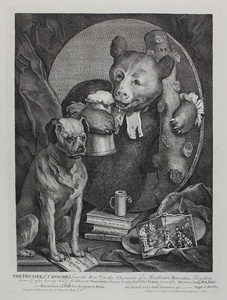| Method | Copper engraving and etching |
| Artist | William Hogarth |
| Published | Design'd and Engraved by Wm. Hogarth. Price 1s. 6d. Publish'd according to Act of Parliament August 1. 1763. [J & J Boydell, c.1795] |
| Dimensions | Image 339 x 258 mm, Sheet 369 x 268 mm |
| Notes |
A drastic reworking of one of Hogarth's earlier self-portraits, to become a biting lampoon of the satirist and poet, Charles Churchill. In 1763, Churchill published An Epistle to William Hogarth in defence of John Wilkes, whom Hogarth had attacked in a portrait earlier that year. Hogarth's response was to almost completely re-engrave his earlier self-portrait Gulielmus Hogarth, keeping only his pug-dog Trump, the curtain, and the oval canvas that originally depicted the artist himself. His portrait has been replaced by Churchill in the form of a Bear, dressed in the dirty and tattered robes of a clergyman. The bear drools down his front, and holds a tankard of ale in one hand and a Herculean club in the other, the knots of the club engraved with his fallacies and lies. In the foreground, Trump is now made to urinate on a copy of Churchill's Epistle, while one of the books has been re-inscribed so that its title now reads: 'A New Way to Pay Old Debts, A Comedy.' In the corner, a small cartoon in a frame has replaced the original palette and 'Line of Beauty' of the original engraving. In it, a miniature Hogarth whips the dancing bear. He has tethered the bear to a performing monkey, dressed in the accoutrements of John Wilkes. Edmunds suggests that the reworking of the plate also holds extra meaning, in that Hogarth, in reusing an old and worn plate, was disrespecting Churchill still further, suggesting that his portrait is not worthy of a new plate, though Paulson suggests a more pessimistic reading. Hogarth, his work having been superceded by the likes of Churchill, has committed a final act of self-destruction by literally effacing himself from the plate in favour of his new, and less talented, rival. The full title and inscription below reads: The Bruiser, C. Churchill (once the Revd:!) in the Character of a Russian Hercules, Regaling himself after having Kill'd the Monster Caricatura that so Sorely Gall'd his Virtuous friend, the Heaven born Wilkes - But he had a Club this Dragon to Drub, Or he had ne'er don't I warrant ye: - Dragon of Wantley William Hogarth (1697 - 1764) was born in London, the son of an unsuccessful schoolmaster and writer from Westmoreland. After apprenticeship to a goldsmith, he began to produce his own engraved designs in about 1710. He later took up oil painting, starting with small portrait groups called conversation pieces. He went on to create a series of paintings satirising contemporary customs, but based on earlier Italian prints, of which the first was The Harlot's Progress (1731), and perhaps the most famous The Rake's Progress. His engravings were so plagiarised that he lobbied for the Copyright Act of 1735, commonly referred to as 'Hogarth's Act,' as a protection for writers and artists. During the 1730s Hogarth also developed into an original painter of life-sized portraits, and created the first of several history paintings in the grand manner. Paulson 215 vii/viii, BM Satires 4084 Condition: Strong clean impression with full margins. Large waterstain to bottom of sheet, not affecting plate. |
| Framing | unmounted |
| Price | £300.00 |
| Stock ID | 50666 |

